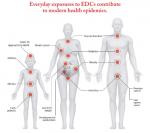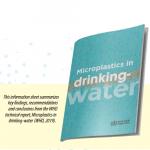Do Stefani Water Purifiers Remove Microplastics?
YES.
The micropores of the ceramic wall of the filter candles trap particles that are .4 microns and larger. This means that metals such as lead, contaminants such as silt or dirt, and microplastics are filtered out of your drinking water at the first stage.
In the next stage, colloidal silver in the inside ceramic wall deactivates viruses, molds and bacteria. In the third stage, activated coconut charcoal attracts and holds on to chemicals such as chlorine and agricultural run off.
What are microplastics?
Plastic is the most prevalent type of marine debris found in our ocean and Great Lakes. Plastic debris can come in all shapes and sizes, but those that are less than five millimeters in length (or about the size of a pencil eraser) are called “microplastics.
~ National Oceanic and Atmospheric Administration
What's harmful about microplastics?
Microplastics that end up in bodies of water can look like food to birds, fish and other creatures. Microplastics can build up in their bodies and lead to starvation. Microplastics also build in their flesh and we eat the microplastic bits along with the fish! The fact that 1/4 of the Earth's surface is covered in plastic - in the form of garbage patches in the oceans - is a threat to all life on this planet!
Okay, but what about us humans?
A most immediate threat to our health and survival are the hormone disrupting chemicals that leach from plastics in to our foods - anything that's canned or packed wet in plastics - and beverages - any drink that bottled in plastic, or in a tetra pack, or plastic lined "paper" cup. The plasticizers that modify fats and oils to create the varieties of plastics we use in packaging, also modify the fats in our bodies - and that means that our hormones, made and stored in fat, can be modified. All of our neurons - nerves and brain cells - are cushioned in fat that could be modified by plasticizers. BPA has become famous amongst the many plasticizers because studies have shown wide ranging problems - from asthma to learning disabilities - that arise in babies and children from exposure. Because all plasticizers by definition modify fats and oils, and because our hormones and nerve cells are made with fats, we can assume that the effects of all plasticizers are unwanted.
More specifically, hormone (aka endocrine) disrupting chemicals clog up our estrogen receptors so they are called xeno (foreign) estrogens. All living being on Earth use the two dozen or so varieties of estrogen to communicate within the body. So when our receptors are filled up with pretend plastic estrogens (with goodness knows what messages or. non messages!) then our own estrogen cannot deliver the messages necessary for the happy functioning of our bodies. The body responds by either over producing estrogen, perhaps leading to estrogen-dependent cancers, and estrogen dominance or sometimes gives up, leading to estrogen deficiency, or the dominance of another hormone. The effects are far beyond reproductive, and can be life changing.
Okay, but what about microplastics in our water
We are pretty sure it's a problem, but we don't know how big. Firstly because microplastics and leachate in water have probably reached most people in the world, so we don't have populations as control groups. Another reason is that we've only just started noticing, and many plastics for everyday use were only introduced in recent decades. Another reason is that very little scientific research is publicly funded and done by non-commercial interests. The only reason a commercial interest would study the problem would be to somehow minimize the problems caused by plastics.
Is it important to reduce the plastic load and the effects of endocrine-disrupting chemicals on the human body? I think so, and so do the scientific community and health authorities.
The bottom line is that it's good for your health, and perhaps most importantly for the health of babies, children and youth, to reduce plastics as best you can. How? Here are my suggestions. Do what you can, when you can. AVOID:
1. CANNED FOODS AND DRINKS Cans are lined with plastic.
2. WET FOODS packed in plastic. Items like tofu blocks tend to be hot packed. Especially avoid acidic or oils items packed in plastic.
3. SMOG from busy streets and parking lots. Walk and spend time near trees and in green spaces, in backyards instead of front yards that face traffic. Petroleum exhaust is responsible for half of our intake of hormone-disrupting chemicals.
4. MICROPLASTICS IN DRINKING WATER Use a micropore ceramic filter to remove micro- and nano- plastics from your drinking water. The size of the pore tells you the size of the microplastics that will be removed. For instance, the Stefani water purifying candle filters have a pore size of 3 microns, meaning that anything lager will be filtered out of the purified water.
Don't panic! ANY FILTRATION WILL HELP. Everything you do can help. And while protecting yourself and your loved ones, let's work together with our governments and businesses to remove plastic waste in our world.
For a deep dive, the World Health Organization offers this report.





